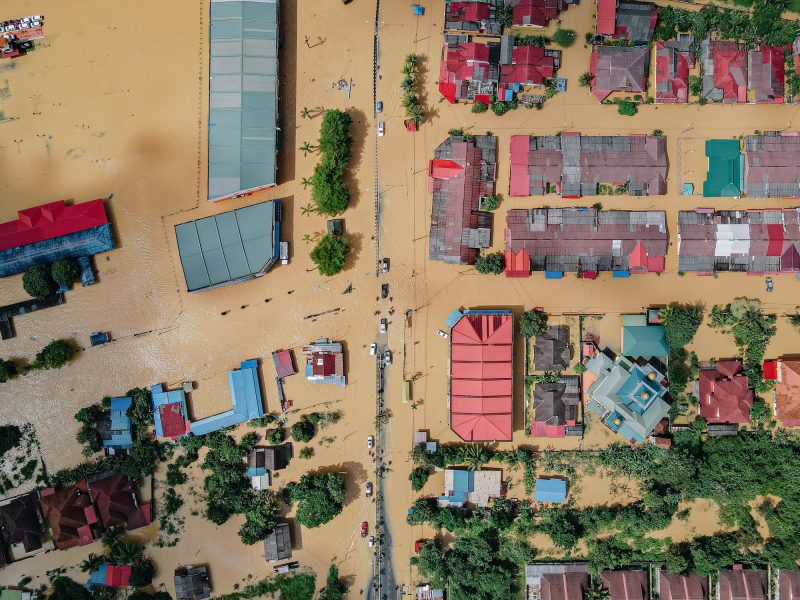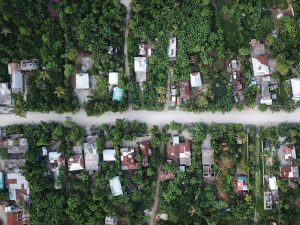Climate change is the long-term shifts in global temperatures and weather patterns, including e.g. levels of rainfall and wind patterns. Human-caused climate change is the most prevalent danger to communities globally, and poorer countries bear the brunt of it. Although climate change impacts every country, it affects some regions worse than others. Bangladesh, a country in South Asia, faces an increased risk of powerful cyclones, rising sea levels, floods and many more. In order to illustrate the role of climate migrants on national and regional security issues, it is crucial to explore the effects of climate change on population movements within Bangladesh and beyond.
Prevalence of Climate Change in Bangladesh
According to the Usanas Foundation, Bangladesh is one of the countries most vulnerable to climate change. It is particularly at risk because of an interplay between the landscape and weather changes in the area. Being on average only nine metres above sea level, Bangladesh is one of the lowest countries in the world, making it especially susceptible to floods. With a population of over 160 million people living in an area that is less than 150,000 square kilometres –i.e. the equivalent of the state of Illinois—it is one of the most densely populated countries in the world with 1330 people per square kilometre. Bangladesh also lacks sufficient financial resources and proper infrastructure to tackle the impacts of climate change effectively.
As a result of these overlapping vulnerabilities, multiple environmental changes have recently befallen the country. In 2017, substantial rainfall forced 400,000 people into temporary shelters or to live in open spaces. A 2019 report estimated that over 5.3 million people were directly affected by recent floods, killing 71 people. Although floods are a regular occurrence in Bangladesh during the monsoon season, the recent floods of 2022 are considered more severe and frequent than previous ones. Bangladeshi environmentalists claimed that a new road network has contributed to the severity of recent floods as it blocked drainage passage. To compound the situation, a report by the World Bank shows that pollution and environmental degradation have considerably decreased the country’s GDP, reducing it by 3.9% to 4.4% in 2019 alone. Together, these recent changes negatively impacted the quality of life of Bangladeshis, forcing many of them to relocate within the country or further afield.
Climate-Induced Migration and Conflict in Bangladesh
Since 2012, six million people, or approximately 3.6% of the population of Bangladesh, have been displaced within the country due to climate change. Most of those displaced are from rural areas which represent 65% of the country’s population. However, their living conditions do not automatically improve once they move to urban areas or cities. The UN estimates that about four million people –many of them displaced due to the impacts of climate change- live in one of Dhaka’s 5000 slums.
While a large influx of climate-induced migrants does not necessarily result in violent conflict with the host communities, the added strain on local resources such as water, jobs and lands may aggravate existing tensions and insecurity. For this reason, climate change is frequently referred to as a threat multiplier because it exacerbates underlying conditions of vulnerability. We can observe this through climate change’s impacts on Bangladesh’s economy. According to a UN official, egregious weather conditions have caused Bangladesh to experience monetary losses worth more than $3.72 billion between 2000 and 2019. Faced with bleak economic prospects, many people opted to relocate.; some within Bangladesh while other relocated across the border to neighbouring India, impacting regional security and politics.
Climate-Induced Migration and Conflict in South Asia
According to 2013 UN data, over 7.8 million Bangladeshi are residing in 89 countries of the world, with India being the largest host country with nearly 3.2 million Bangladeshi migrants. Many of them have relocated to the northeast Indian state of Assam, which borders Bangladesh, as the state is not directly in danger from rising sea levels. The migration pattern from Bangladesh to the region of Assam is arguably the largest international migration movement in the world, according to the Asian development bank.
Ever since the enactment of the politically controversial Indo-Bangladesh Trade Pact in 1972, the relationship between India and Bangladesh has been tense and recent influxes of climate-induced Bangladeshi migrants to India have not done anything to alleviate the situation. In 2012, members of the Bodo tribe and Muslim residents clashed over the building of a Mosque, resulting in 100 people killed and over 400,000 displaced. Shortly after, people in Assam resorted to public demonstrations against immigrants from Bangladesh, demanding their identification and deportation, thus highlighting how migration—and even more importantly, the perception that there has been an increase in immigration—can become politicized and securitized in Assam.
Regional Impacts of Climate-Induced Migration
Large influxes of climate-induced migrants to a neighbouring country are not unique to Bangladesh and India: this has occurred all over South Asia. Nearly half of the population of South Asia presently live in areas that are expected to become moderate to severe hotspots for climate change by 2050. The vulnerability, due to loss of properties and livelihood caused by floods, and droughts among others, of many areas in the region, has led to the internal and international migration of people to neighbouring as well as distant locations.
Climate scientists predict that we are going to see an increase in climate change in all regions of the world in the near future. But with the right forms of preventative actions, governments can alleviate the risk of more climate vulnerability in all regions of the world. To reduce the impact of this impending crisis, governments across South Asia have created laws and policies to mitigate migration caused by climate change. One notable implementation is the recent construction of entirely new islands by the government in the Maldives to serve as new dwellings on higher grounds for people displaced in the country. As a blog post from the Wilson Center recommends, governments can further encourage more sustenance opportunities in non-agricultural sectors, a major source of employment in South Asia, while global bodies can organize and fund joint efforts meant to combat climate change in countries most affected by it, promoting enhanced trade among countries in the region. These actions and initiatives at the national and international levels are vital, especially given how willful negligence by political actors across the globe means that climate change is not coming to an end any time soon.





